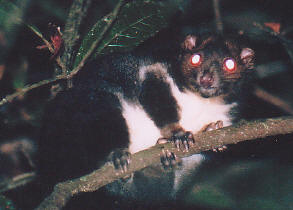Herbert River Ringtail Possum

Photo: Courtesy of Damon Ramsey
BSc.(Zool) Biologist Guide
Herbert River Ringtail Possum: Pseudocheirus herbertensis - Colours can vary from almost black to pale fawn above, with white chests and bellies
- The fawn species tend to have a longitudinal median dark stripe on the head.
- Pointed face
- Tapered tail.
- Fairly sparse and limited in distribution.
Habitat: - The Herbert River Ringtail Possum lives above an altitude of about three hundred metres in the dense rainforest of North Queensland.
- An arboreal animal, it rarely descends down to the ground.
- Strictly a nocturnal animal, tree hollows are the favoured daytime resting site as well as large clumps of epiphytic ferns.
Diet: - The bulk of its diet is received from rainforest leaves, but it occasionally eats fruits such as the Silver Quandong and flowers of trees such as the Bumpy Satin Ash.
Social Behaviour: - It is a solitary animal, dens are not shared by adults.
- Groups of two or three have been seen in the same tree at night, but this is probably due to the males being attracted to females on heat.
- Vocally, adults give a buccal click under stress and a variety of screeches and grunts when antagonised.
Viewing Opportunities: - At Chambers Wildlife Rainforest Lodge when there is new growth on the closest large tree to lodge 4, and Herbert River Ringtail Possums can be seen feeding there.
- Sightings are also common along the top road.
- Can also be viewed with a spotlight, at the Crater National Park, on the Malanda falls Environmental Park walking paths, The Curtain Fig Tree and along the roadway on Thomas Road.
Breeding and Rearing: - Gestation period is approximately 13 - 14 days.
- Pouch life is 4 to 5 months, indicating a mating peak between April and May. The young ride on their mother’s back for a short amount of time before being left in the nest to make increasingly longer forays, as they become older.
- They have a forward-opening pouch with two teats, and two young are usually reared. These have been recorded from March to October, and newly emerged young throughout the year but with a noticeable peak in October.
- When separated from their mothers, the young produce a very quiet high-pitched rapid chatter that leads the mother to move towards them again.
Additional Information: - Another name for the Herbert River Ringtail Possum is the Mongan.
- There are two subspecies, the Pseudocheirus herbertensis herbertensis (Kuranda south) and the Pseudocheirus herbertensis cinereus (Mount Lewis north).
- It is evenly but sparsely distributed throughout this range, with 0.5 to 3 individuals being seen per hour of spotlighting, giving them a status of sparse and limited.
- It has a nest similar to that of the Common Ringtail Possum, reported to have been seen in areas of low swampy rainforest to areas of open forest. These are probably built when holes are not available.
- Discovered by Lumholtz in the Herbert River Valley during the 1880's.
- Average life span 4 - 5 yrs.
- This possum was once hunted by the Aboriginal people with the aid of a climbing cane and searching in fern clumps.
- Carpet snakes are known to be predators of the Herbert River Ringtail Possum, but the greatest threat is rainforest clearing. Long term effects of selective logging are not known, but the possum is still present in forests which have been logged.
Additional Information: Courtesy of Damon Ramsey This possum is, understandably, the symbol of the Queensland National Parks and Wildlife Service, despite the fact that most Queenslanders would not have seen, nor probably even heard of this species. This is mainly due to the fact that they are pretty much restricted to tropical rainforest in north Queensland above 350 metres or so (Menkhorst and Knight 2002).
Script: Courtesy of Damon Ramsey BSc.(Zool) Biologist Guide
Additional Herbert River Possum Photos Additional Herbert River Possum Photos 2
|
